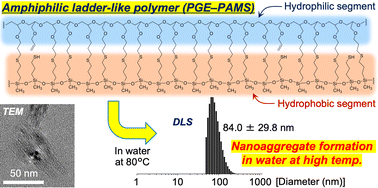Aiming to enhance the high-temperature stability of nanoaggregates of amphiphilic polymers in water, an amphiphilic ladder-like (double-chain) polymer (PGE–PAMS) was successfully prepared via the thiol–ene reaction between 3-mercaptopropyldimethoxymethylsilane and poly(allyl glycidyl ether), followed by intramolecular polycondensation (template polymerization) of the dimethoxysilyl groups in the side chains of the resulting polymer. Solubility tests, FT-IR spectroscopy, 1H NMR spectroscopy, 29Si NMR spectroscopy and transmission electron microscopy confirmed that PGE–PAMS possesses a ladder-like structure, where the hydrophilic poly(glycidyl ether) chain and the hydrophobic polyalkylmethylsiloxane chain are linked in parallel by sulfide bonds. PGE–PAMS formed nanoaggregates with a diameter of ca. 60–70 nm in water, which were stable even at high temperatures (80 °C–90 °C). Additionally, in water containing a small amount of N,N-dimethylformamide, the PGE–PAMS nanoaggregates could solubilize tetraphenylporphyrin, a hydrophobic dye, and stably retain it even at a high temperature of 90 °C.
